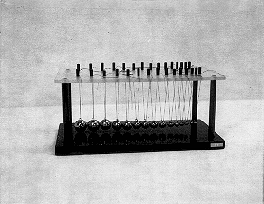

PURPOSE: To demonstrate how the velocity is multiplied by a sequence of collisions between balls of decreasing mass.
DESCRIPTION: A ball of mass M moving with velocity V strikes a ball of mass m (less than M) initially at rest. For an elastic collision the velocity v with which the lighter ball leaves the scene will be v = 2VM/(M+m). This device has a series of balls, with masses in the same geometric ratio, to provide a velocity multiplication of about 16 from the biggest to the smallest.
SUGGESTIONS: To prevent a cataclysmic mess, limit the displacement of the first ball to about one centimeter.
REFERENCES: (PIRA 1N30.25.) See Demonstration Reference File for further information, including details in the derivation of the velocity multiplication effect.
EQUIPMENT: Graduated mass collision ball apparatus, as photographed.
SETUP TIME: None.
 |  |
 |  |
 |